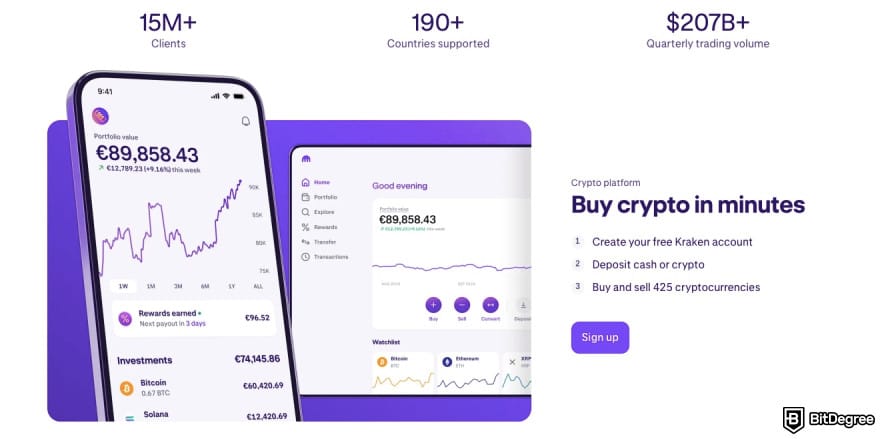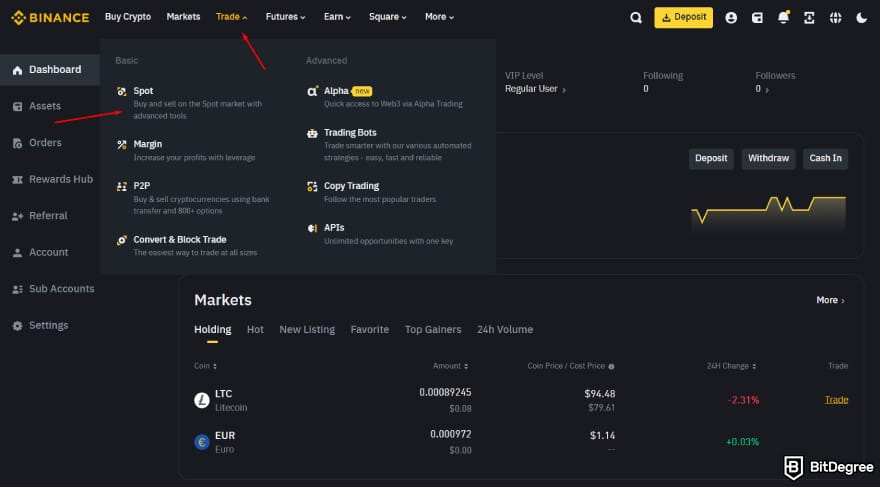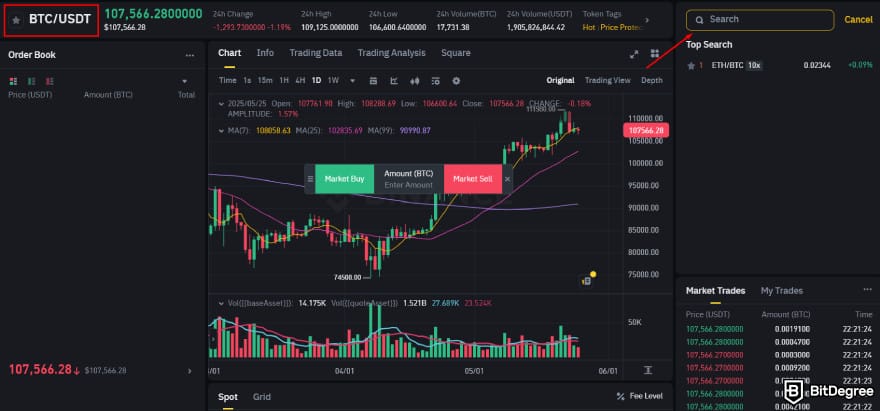Key Takeaways
- The crypto world is rapidly changing, so learning how to get into crypto can be overwhelming. Beginners should start with basic terminology, focus on obtaining a crypto wallet, and acquire some well-researched cryptocurrencies;
- BitDegree aims to help people quickly onboard to the crypto space. Numerous in-depth guides, a comprehensive handbook, and gamified learning materials allow for a smooth and interactive learning experience;
- You can explore areas such as staking or NFTs if you’re ready to advance your trading strategy.
Ace quick missions & earn crypto rewards while gaining real-world Web3 skills. Participate Now ! 🔥
The financial landscape is changing, with new and exciting ventures available worldwide. From new ETFs to NFTs, people eagerly diversify their investment portfolios and learn how to get into crypto trading as an addition to their traditional investing habits!
While the crypto world can initially seem daunting, you simply need to know the basics to get started. Afterward, your knowledge of crypto trading will increase with time and experience. However, don’t forget to stay updated on market trends to avoid taking unnecessary risks. The best way to do so is to follow news pages and subscribe to a newsletter, such as Daily Squeeze.
There is plenty of educational material on BitDegree to familiarize yourself with the crypto space. From helpful tutorials to comprehensive reviews about crypto exchanges like Binance or Kraken, your journey to understanding the crypto world can start here.

Did you know?
Subscribe - We publish new crypto explainer videos every week!
Candlesticks, Trendlines & Patterns Easily Explained (Animated Examples)


Table of Contents
- 1. Understanding Cryptocurrencies
- 1.1. What is Cryptocurrency?
- 1.2. What is Blockchain Technology?
- 1.3. Popular Cryptocurrencies
- 2. Choosing a Crypto Wallet
- 2.1. Types of Crypto Wallets
- 2.2. What Crypto Wallet is Best for You?
- 2.3. Popular Crypto Wallets
- 3. Trading Cryptocurrencies
- 3.1. Centralized Exchanges (CEXs) VS Decentralized Exchanges (DEXs)
- 3.2. How to Buy Your First Cryptocurrency
- 3.3. Selling and Withdrawing Funds
- 4. How to Get Into Crypto With BitDegree
- 4.1. Starting with Beginner-Friendly Content
- 4.2. Advancing to the Next Level
- 5. Conclusions
Understanding Cryptocurrencies
First, you need to know the definition of cryptocurrencies, blockchain, and other essential aspects of digital asset management. Learning how to get into crypto starts with the boring stuff, but once you get it, you’ll be on your way to success!
Latest Deal Active Right Now:Don’t just pass GO, snag the limited edition Ledger Flex x Monopoly Bitcoin bundle and get a mystery BTC voucher worth up to $500. Hurry up, only available until the supply runs out!
What is Cryptocurrency?
Cryptocurrencies are digital or virtual assets that operate outside traditional financial systems. There’s still much debate about whether cryptocurrencies should be categorized in the same asset class as money. However, the growing interest in this field allows for broader adaptation of crypto as a payment method.
Learning how to get into crypto will lead you to the term “decentralization“, meaning no central authority controls crypto.[1] It’s not issued by the government like fiat currencies and exists mostly on blockchain technology.
While the decentralized nature of crypto transactions remains a core principle, this isn’t always true. The rising popularity of cryptocurrencies led to a more controlled environment called “centralized crypto exchanges” (CEXs), such as Binance or Kraken.

Another vital attribute of cryptocurrencies is transparency. All crypto transactions will have public ledger or blockchain records, so anyone can verify and trace back historic transactions! Such efforts are essential to prevent fraud or other illicit activities.
Due to the nature of crypto transactions, once it’s recorded on a public ledger, nobody can change that information. That’s why immutability plays a considerable role in protecting the transaction history and making it a reliable source of information!
You might encounter tokens, altcoins, and other concepts related to the crypto world. BitDegree explains the difference between them and generally defines cryptocurrencies as the umbrella term. Meanwhile, coins and tokens are simply currencies with different use cases and dependencies on the underlying blockchain.
What is Blockchain Technology?
So, you might be wondering how to learn crypto, but you first need to know how crypto transactions are recorded. After all, once you start trading, you won’t be able to cancel or backtrack on any transactions!
Blockchain technology powers the whole crypto world. It’s also known as a distributed ledger. Simply put, it’s a database with numerous transactions, timestamps and other relevant information. There are some nuances when discussing the operations and security of blockchain that can be useful to know if you’re just starting your crypto journey!
So, cryptocurrencies operate on blockchain technology and a distributed ledger records every transaction across an extensive network of computers.[2] The blockchain is comprised of “blocks” that store lists of these transactions.

Once the block is complete, it becomes a part of the chain in a linear and chronological order. Thus, blocks form a chain and make up the blockchain!
Blockchain technology employs cryptography to ensure the security of each block. So, your transaction records are safe and won’t have the risk of being altered in any way.
Various industries adopt blockchain technology to speed up their processes, improve transaction security, and stay ahead of the game! On BitDegree, we’ve covered extensive use cases of blockchain technology so that you can learn more about its applications in supply chain management, healthcare, and retail.
Popular Cryptocurrencies
Bitcoin is the largest cryptocurrency by market capitalization and defines the whole crypto landscape. Created by the mysterious Satoshi Nakamoto, Bitcoin introduced the concept of decentralized digital currency to the world.
Consequently, other projects began emerging after Bitcoin, and now we can enjoy the variety! The underlying cryptos for these projects are also known as “altcoins”. For example, the second-largest cryptocurrency, ETH, is an altcoin created for Ethereum, a network for building decentralized applications and other Web3 advancements.

Tens of thousands of crypto coins and tokens, from Ripple and Dogecoin to lesser-known projects, are available on the market today. As the crypto market is volatile and often unpredictable, make sure to research each project before investing your money in it.
You can find all the important information on the BitDegree tracker, where you can see the latest trading volumes, price changes, and overall trends of different cryptocurrencies. If you click on your selected coin, you’ll find detailed information with links to the project’s website, community pages, and even website traffic if relevant to you!
Choosing a Crypto Wallet
People often discuss how to get into crypto by recommending crypto wallets, and it’s one of the most important things to learn before diving into trading! Think of it as your regular wallet where you keep your cash. So, crypto wallets act as a safe space to store your digital assets, just like you would do with your fiat money.
However, you might need help with the wide selection of crypto wallets. They all market themselves as the best, most secure, innovative and interconnected. It can be hard to discover the truth for yourself. That’s why BitDegree tests crypto wallets and reviews them to give you all the juicy information so you can make a well-informed decision!

Before diving deeper into the best wallets, let’s review crypto storage types. When researching how to learn crypto, you’ll find many recommendations about getting a cold wallet to enhance security. While this is great advice, you need to know what it is before buying it, so let’s dive in.
Types of Crypto Wallets
There are two types of crypto wallets - hot and cold storage. Often, people looking for how to get into crypto start their journey with a hot wallet. It’s typically free to use, and you can easily access it for everyday use.
Many hot wallets operate on mobile devices, so you can pull out your phone and complete a transaction while on the go. You can also download a desktop wallet on your computer. Convenience and speed are the main benefits of having this type of storage.
Moreover, web wallets offer an advanced level of convenience if you want to easily trade cryptocurrencies. A good example of a web wallet is using a crypto exchange like Binance with an integrated exchange-based wallet.

Another type of wallet is a cold wallet, and its main advantage is that it stores your digital assets offline. Cold wallets provide a higher security level than hot wallets as they aren’t exposed to cybersecurity breaches.
There are two categories of cold storage - hardware and paper wallets. Before you know how to get into crypto, you might keep your public and private keys in a paper wallet without realizing it.
If you print them out or write them on a piece of paper, you already have a paper wallet! It’s a relatively safe and beginner-friendly way to keep your assets secure. Nevertheless, make sure to keep paper wallets safe so that you don’t lose them. Such advice applies to all of your private keys!

So, consider investing in a hardware wallet once you start acquiring more assets. It’s the most secure way to protect your cryptocurrencies. These physical devices never connect to the internet except when transferring funds. Also, they have PIN codes, 2-factor authentication, and other security measures that prevent unauthorized access.
Some of the best hardware wallets are Ledger Flex, Stax, and Trezor Safe 5.
Keep in mind that hardware wallets are an investment and can be costly for beginners. You can buy cold storage starting from $69, so manage your money accordingly and evaluate the need for a hardware wallet in your case.

Did you know?
Subscribe - We publish new crypto explainer videos every week!
Paper Hands vs Diamond Hands: Crypto Slang Explained (ANIMATED)


What Crypto Wallet is Best for You?
Choosing a crypto wallet is an individual decision when learning how to start investing in crypto. You need to evaluate such factors as the price of a crypto wallet, security measures, convenience, supported cryptocurrencies, and others.
If you’re struggling to find the best crypto wallet on your own, make sure to read expert reviews that cover all the pros and cons. From comprehensive guides on what is a crypto wallet is to countless tutorials on how to set it up, you can find all the information you need in articles written by seasoned crypto traders.
Popular Crypto Wallets
Some crypto wallets are fan-favorites, and they’re trusted by millions of traders worldwide. Due to their commitment to security and long-term focus on user experience, they might be a good choice for both novices and experienced traders. Make sure to read in-depth reviews about them to learn the nuances!
For example, one of the most popular and recommended cold wallets is Ledger Flex. While it costs $249, its enhanced security measures are definitely worth it.
It has 2-factor authentication, PIN codes, multi-signature, and backup options with recovery phrases. Furthermore, Ledger Flex supports over 5,500 cryptocurrencies, so you can store most of the popular coins & tokens in this wallet!

If you need convenience, you’ll love Ledger Live, a mobile or desktop application that helps you manage your assets on the go. Additionally, Ledger Flex offers interoperability with some of the most popular hot wallets on the market.
A cheaper alternative is Trezor Safe 5. It’s a hardware wallet that costs $169. Its security is enhanced with the EA6+ NDA-free secure element chip, which is also used to guard data in cards and passports. The Trezor Safe 5 is not only protected from inside, but it's also shielded from the outside by using Gorilla Glass, which is the industry leader in screen protection.
Trezor Safe 5 is fully open-sourced, enabling users to verify each process' integrity.
If you’re on the hunt for a software wallet, check out Binance Wallet. It’s an excellent choice for anyone looking to manage their assets wherever and whenever. Also, the robust security measures allow you to safely manage, trade, and monitor your digital assets.
You can enjoy the benefits of a built-in centralized crypto exchange since Binance introduced this wallet to provide more convenience for its users. Numerous features and supported coins allow you to explore the world of crypto on a single app. That’s why Binance Wallet is a TOP choice for anyone who wants to get a software wallet.
Another recommendation for a hot wallet is Coinbase Wallet. It’s a popular software wallet provided by Coinbase, a leading cryptocurrency exchange known for its user-friendly interface and versatility.

With top-notch security features and thousands of supported digital assets, Coinbase Wallet is a great choice for novices and seasoned traders. You’ll quickly find everything you need on this wallet, including dApps, altcoins, and integration with the Coinbase exchange.
Trading Cryptocurrencies
Once you learn the basics of how to get into crypto, the next step is to go into the real crypto world. This step includes browsing different crypto exchanges and choosing which one to start trading on! Afterward, the process is straightforward - you need to sign up on a crypto exchange, deposit funds and buy your first crypto!
Centralized Exchanges (CEXs) VS Decentralized Exchanges (DEXs)
Before embarking on the journey of how to get into crypto exchanges, you need to know that these platforms can be centralized or decentralized. CEXs are crypto exchanges with a central authority so that you can buy and sell cryptocurrencies through an intermediary.
The users of CEXs trust this central authority to verify their transactions, maintain order books, and keep their digital assets safe. Therefore, the CEX manages your funds and private keys. You don’t have direct control over your cryptocurrencies, so you entrust the CEX to keep your assets safe.
A great example of a CEX is Bybit. It’s one of the leading crypto exchanges in the world, and it’s popular among crypto enthusiasts due to its user-friendly interface, reliability, and high trading volume.

On the other hand, a DEX platform operates on peer-to-peer trading of cryptocurrencies without the need for a central authority or intermediary. Smart contracts are essential in such trades since they allow for automatic transactions if all the conditions are met.
DEXs allow for more transparency since traders need to trust the code of smart contracts rather than a central authority to verify their trades. Also, you have full control over your private keys and assets, reducing the risk of large-scale theft or cyberattacks.
However, DEXs often have lower trading volume than CEXs and less intuitive interfaces that might seem unattractive to people. Slower trades and higher price slippage cause many traders to migrate to a more trustworthy CEX like Binance.
📚 Read More: Binance Review
One of the most popular DEXs is Uniswap, with numerous features and projects available at your fingertips. So, if you’re looking for a well-known DEX to try your hand at trading, you might like Uniswap and its unique liquidity pools!
How to Buy Your First Cryptocurrency
After learning how to get into crypto and choosing your first crypto exchange, you’ll need to sign up for an account if you start trading on a CEX. The flow is slightly different if you choose a DEX since there won’t be any accounts - just your wallet. For the sake of beginner-friendliness, I’ll cover the CEX flow, using Binance as an example.






Notably, as I've mentioned, the safest way to store your crypto is via a cold wallet, such as Ledger Flex.
Selling and Withdrawing Funds
Once you know how to get into crypto, you’ll need to know how to sell your coins. It’s pretty simple since most crypto exchanges have intuitive designs. Here are the steps for the same exchange - Binance.



Once filled, the fiat or token proceeds will be credited to your Spot wallet.
How to Get Into Crypto With BitDegree
Learning how to get into crypto might be challenging for beginners, so BitDegree aims to provide you with simple and informative guides. Numerous tutorials, reviews, listicles, news coverage, and gamified education tools give you a chance to explore and build your knowledge!
Starting with Beginner-Friendly Content
Firstly, you might want to start with the BitDegree Crypto 101 Beginner Handbook! It covers all of the most important crypto topics in 10 broad chapters. The best part is that this handbook is free of charge, so you can explore how to get into crypto without paying a single dime.
Secondly, various tutorials and in-depth guides await you on the BitDegree website. From general topics like crypto wallets to more specific ones regarding mining or staking, you can browse our website and search for a topic you are interested in!

If you’re struggling with crypto slang, you can find every definition you need on BitDegree’s Crypto Glossary. I recommend starting with BitDegree’s guides and consulting the glossary in case you’re unfamiliar with some terms. Crypto Glossary is comprehensive and pretty long, so don’t think you need to read it all in one go!

- Secure and reliable
- Accepts fiat currencies
- Lots of trading options
- Reputable exchange
- Accepts fiat currencies
- Offers various trading options

- Advanced trading options
- Demo trading
- Very low fees
- Beginner-friendly
- Great fees
- Demo trading

- Instant Buy/Sell functionality
- Multiple cryptocurrencies support
- Bitexen Research section for market analysis
- Instant Buy/Sell functionality
- Spot trading with Turkish Lira pairs
- EXEN native token utility
Advancing to the Next Level
Once you familiarize yourself with the glossary and tutorials, you can pick up reading BitDegree news! It likely won’t cover how to get into crypto trading for beginners, but it proves to be a great tool to track trends in the crypto space. So, you can read the daily news and see if anything catches your attention - perhaps you’ll want to take action depending on the latest happenings in Web3!
BitDegree Missions are the latest iteration of BitDegree’s take on crypto & Web3 education. Their design allows you to explore different crypto exchanges, wallets, and other concepts. Moreover, you can take designated Web3 Exams to test your knowledge. Both of these features allow you to earn rewards while learning with BitDegree!
Conclusions
Exploring how to get into crypto can be overwhelming for people who know nothing about this space. However, it doesn’t need to be complicated! You can quickly learn about crypto with the right resources and be on your way to purchasing your first coins.
BitDegree provides easy-to-follow guides and educational material so that you can understand the terminology, processes, and important steps in your trading journey. If you need gamified content, check out Missions. There’s even daily news regarding crypto, so you can stay on top of the trends.
So, build your knowledge about crypto wallets and explore the recommended Ledger Flex or Trezor Safe 5. See what different crypto exchanges like Binance or Kraken have to offer. Once you get past the beginner steps, you can navigate the crypto space with much more ease.
The content published on this website is not aimed to give any kind of financial, investment, trading, or any other form of advice. BitDegree.org does not endorse or suggest you to buy, sell or hold any kind of cryptocurrency. Before making financial investment decisions, do consult your financial advisor.
Scientific References
1. Walch A.: 'Deconstructing 'Decentralization': Exploring the Core Claim of Crypto Systems';
2. Yaga D., Mell P., Roby N., Scarfone K.: 'Blockchain Technology Overview'.



.jpg?tr=w-400)








